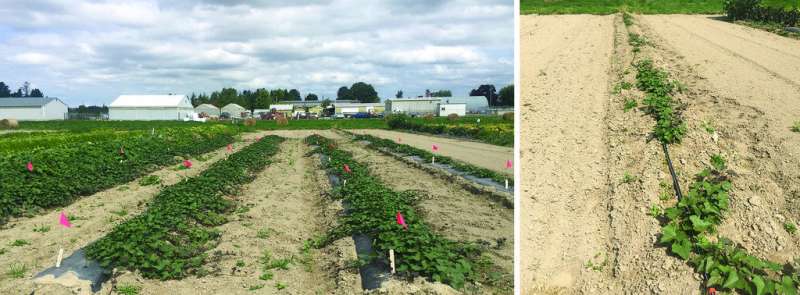Steps for successfully growing sweet potatoes in Washington

Sweet potato (Ipomoea batatas) production in the northern United States is limited due to the perceived barriers of a short growing season and relatively cool summer temperatures, yet recent studies have shown yield in northern regions can be greater than the national average when sweet potatoes are grown with plastic mulch. A study, now published in HortTechnology, was conducted in northwest Washington to evaluate the productivity of "Covington" sweet potato with polyethylene (PE) and soil-biodegradable (BDM) mulches and different in-row spacings (20, 30, and 38 cm) in 2019.
The objective of a 2019 experiment was to ascertain whether sweet potatoes could be successfully grown in northwest Washington. Specific objectives were to 1) compare the impacts of PE mulch and BDM and different in-row spacings on productivity in northwest Washington, and 2) identify potential pest threats of sweet potato production in this region and evaluate resistant accessions to manage the pest problem. Although many of the sweet potato slips arrived for the experiment in poor health due to travel issues, there were enough slips for researchers to successfully conclude that wireworm proved to be the only pest that severely affected sweet potato production, damaging 98% of storage roots.
The objective of a 2020 experiment was then to evaluate wireworm-resistant accessions. Eight wireworm-resistant sweet potato accessions were received from the USDA, Agricultural Research Service. Plant material arrived as tissue culture plantlets and on arrival were washed and transplanted into sterilized 4-inch pots filled with autoclaved potting mix (the same product as in 2019) that was lightly moistened and placed into a humidity box. Two accessions did not survive, and the remaining six accessions were propagated by vine cuttings in the greenhouse. The six accessions were transplanted in the same field where sweet potatoes were grown in 2019. On average, only 16% of the crop was damaged by wireworm.
Both PE and BDM mulch increased soil temperature and led plants to become established and grow more quickly. Mulch type did not significantly affect total yield, but the yield was higher with PE and there were seven times more jumbo sweet potatoes with PE mulch. One disadvantage of PE mulch is that it must be removed prior to harvest, while BDM mulch does not need to be removed or disposed of at the end of the season.
The study demonstrates there is potential to grow sweet potatoes successfully in northwest Washington for local fresh and processing markets. However, there are several limitations to production that must be addressed: sourcing a regional, reliable supply of healthy sweet potato slips; developing techniques to reduce wireworm damage; including genetic resistance; and the ability to increase field soil temperature.
More information: Srijana Shrestha et al, Plastic Mulch and In-row Spacing Effects on Sweetpotato Yield in Northwest Washington, HortTechnology (2022).
Journal information: HortTechnology
Provided by American Society for Horticultural Science


















